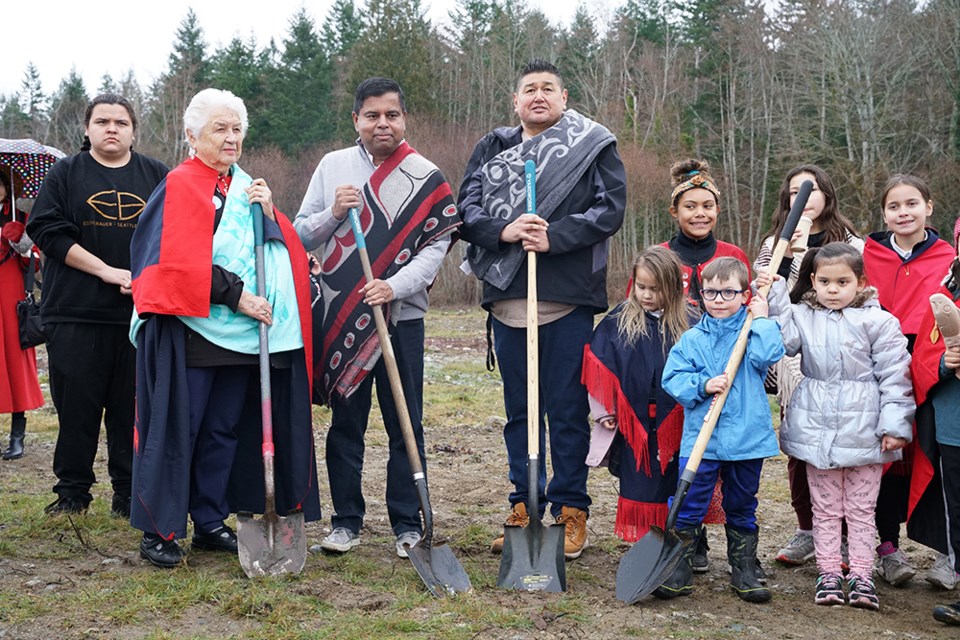Tla’amin Nation held a special ceremony to bless the ground for its new Ɂəms ʔayɛ (uhms aya) Cultural Centre and Traditional Foods Processing Facility.
Ɂəms ʔayɛ (Our House) Cultural Centre will include a 2,000-square-foot feast hall and cultural gathering space that will accommodate up to 350 guests and be used for sharing songs, dances, ceremony and feasting.
Located in the heart of the t̓išosəm community, it will play a vital role in the promotion of Tla’amin language, culture, food security and well-being, according to a media release.
At the February 20 ceremony, Tla’amin elder Elsie Paul said a prayer to open the ceremony. First speaking in the Tla’amin language, Paul said the community was looking forward to Ɂəms ʔayɛ (Our House) and that everything will go well and according to the plan.
“Thanks to the people who do the hard work,” said Paul.
Hegus John Hackett welcomed those assembled to the ground-blessing ceremony.
“Today we are here to bless the ground so construction can begin on Ɂəms ʔayɛ Cultural Centre and Traditional Foods Processing Facility,” said Hackett. “On behalf of the legislative assembly, we want to honour and thank our elders, children and Tla’amin citizens for being here to bear witness to the ground blessing.”
Hackett said before the ceremony, food was burned for the ancestors, who had waited a long time.
“We invited them to celebrate with us today,” said Hackett. “I want to acknowledge and raise my hands to our elders and ancestors for keeping the cultural traditions alive. Ɂəms ʔayɛ is going to be the new training ground to elevate our culture even further and to be home to our sacred artifacts. It will be a place where elders can share teachings as a way of our ancestors.
“We will be working together as a community to revitalize our language, culture and teachings to honour our elders.”
Hackett said it was a good day to be Tla’amin.
Real reflection
Federal minister of crown and Indigenous relations Gary Anandasangaree said he’d had an incredible afternoon meeting with members of the legislative assembly. He said he wanted to acknowledge the elders.
Anandasangaree said Ɂəms ʔayɛ is an important symbol, but more importantly, a real reflection on the perseverance of the Tla’amin community for decades.
“In the face of all the things that have happened as part of the colonial experience which is Canada, and the impact it has had on your people, I want to say that this is the beginning of a centre that focuses on revitalization on preserving culture and language,” said Anandasangaree. “It is so important to future generations and we see a lot of young people here today who are going to benefit from the language, training and teachings that are going to come from here.
“We know the legacy from residential schools and other practices of the federal government has worked toward dismantling language and culture. This is a very small way for us to start rebuilding.”
Anandasangaree said Tla’amin’s treaty allows self-determination and he wants to ensure its people have control over every aspect of their lives.
“You stand strong, you stand vibrant and you stand as a people,” said Anandasangaree.
Uplifting elders
Tla’amin director of public works and capital infrastructure Carmen Galligos said Ɂəms ʔayɛ had been a long time coming. She said when people look back and see the black and white photos, they think residential schools were long ago, but in her family, it was only one generation ago.
“Our culture was actively and intentionally being taken away from us,” said Galligos. “Today, Tla’amin is uplifting those elders who brought us here today. It’s because of you that we still have a language to learn and record.”
Galligos said Ɂəms ʔayɛ is going to be a beautiful place to repair, restore and regrow culture and language. She said the desire is to create a place worthy of the elders’ sacrifice.
Holding knowledge
North Island-Powell River MP Rachel Blaney thanked the elders and said she appreciates the stories and the holding of knowledge.
“I always think of my granny who went to residential school from four to 16 and I didn’t find out she was in residential school until I was in university learning about residential schools,” said Blaney. “I called home and asked and they told me that she had gone. I remember her always saying to me, no complaining – we’re still here. There’s work to be done.
“I’m grateful to be here to acknowledge this amazing day. We’ll keep fighting because we’re still here.”
There was then a cultural ceremony to bless the land where Ɂəms ʔayɛ will be built, with singing, drumming and the brushing of cedar blows.
According to the media release, funding for the project was announced in 2022, with the federal government contributing $3,158,508 and the province adding $1,053,169.
The facility is planned to be a cultural hub of more than 15,000 square feet in size, and include a feast hall, traditional foods facility, language lab, museum and archives, medicinal gardens and a communal smokehouse.
Join the Peak's email list for the top headlines right in your inbox Monday to Friday.



